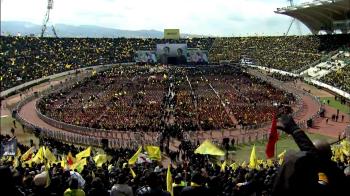Alwaght- Wadi al-Salam, which translates to Valley of Peace, is an ancient Islamic cemetery stretching near the holy city of Najaf, Iraq. Indeed, it is a city in itself as it has more tombs than most cities’ populations. The ever-growing graveyard contains up to five million bodies and the number continues to grow each year. Apart from being the largest graveyard in the world, what makes it special is its spiritual aura and having been described as “part of heaven.”
It is estimated that 500,000 bodies are buried at the site every year making it the largest cemetery on earth.
Millions of Shiite Muslims wish that Wadi al-Salam could be their final resting place and many even make it part of their will. The reason why so many people revere the location is because tradition has it that it is a piece of heaven on earth.
The site is adjacent to the shrine of Imam Ali bin Abi Talib, Islam’s first Imam and successor of Prophet Mohammad. Hence, the cemetery which dates back 1,500 years, is cherished. Most Iraqi Shiites would like to be buried near the beloved Imam.
The cemetery stretches for 1485.5 acres and the “city of the dead” is more populous than Najaf, one of Iraq’s largest cities. It houses the remains of millions of people including hundreds of Islamic religious figures, clerics— including Ayatollah Mohammad Baqer al-Sadr—and political and social leaders.
The process of burial at Wadi al-Salam remains unchanged for 1,400, making it rather unique. Graves are built with baked bricks and plaster that differ in height and size. Crypts can also be found there and are capable of keeping up to 50 bodies. In addition, types of burials vary with some having lower graves, towers or underground vaults.
Before the deceased is laid to his/her final resting place, some rituals are carried out including washing the body and wrapping it in a cloth referred to as Kafan, funeral prayers inside the shrine of Imam Ali and recitation of verses of the holy Quran at the cemetery.
Wadi al-Salam has embraced the bodies of people from all over the world including Southeast Asia, India, Pakistan, Iran, and Persian-Gulf states. At the moment of burial, the land knows no discrimination; everyone is equal.
It was added to UNESCO’s list of World Heritage Sites in 2012.
The historical and religious significance of the location is related to the tradition that claims Prophet Abraham bought land in Wadi al-Salam. It also relates that Imam Ali dubbed it as a piece of heaven, hence the wide veneration.
Not only that, but the fact that it is so close to Imam Ali’s shrine is yet another motive behind the burials as many Shiites believe that he has the power to intercede for his followers. Should they be buried there, “they will be raised from the dead on judgment day with their spiritual leader.” Even if not, the believer’s soul will be transported there.
Hadith relates Imam Ali as saying: “This Valley of Peace (Wadi al-Salam) is part of Heaven and that there is not a single one of the believers in the world, whether he dies in the East or West, but his soul will come to this Paradise to rest.”
“As there is nothing hidden in this world from my eyes,” Imam Ali continued, “I see all the believers seated here in groups and talking with one another.”
Imam Ali bin Abi Talib was the Prophet Muhammad’s cousin and son-in-law whom, on the day of Ghadeer, the prophet delivered a speech naming him as his successor. Imam Ali was the first male to convert to Islam and was the only man to be born inside the Kaaba, the house of God around which millions of Muslims perform pilgrimage every year.
Many prophets are also interred there, including the Prophet Hud and Prophet Saleh.
Body and soul will eventually separate and between life and death there is a thin thread ready to be broken any second. So, for Shiite Muslims Wadi Al-Salam—part of heaven on earth—is a place to be yearned for in the hope of eternal peace.



























